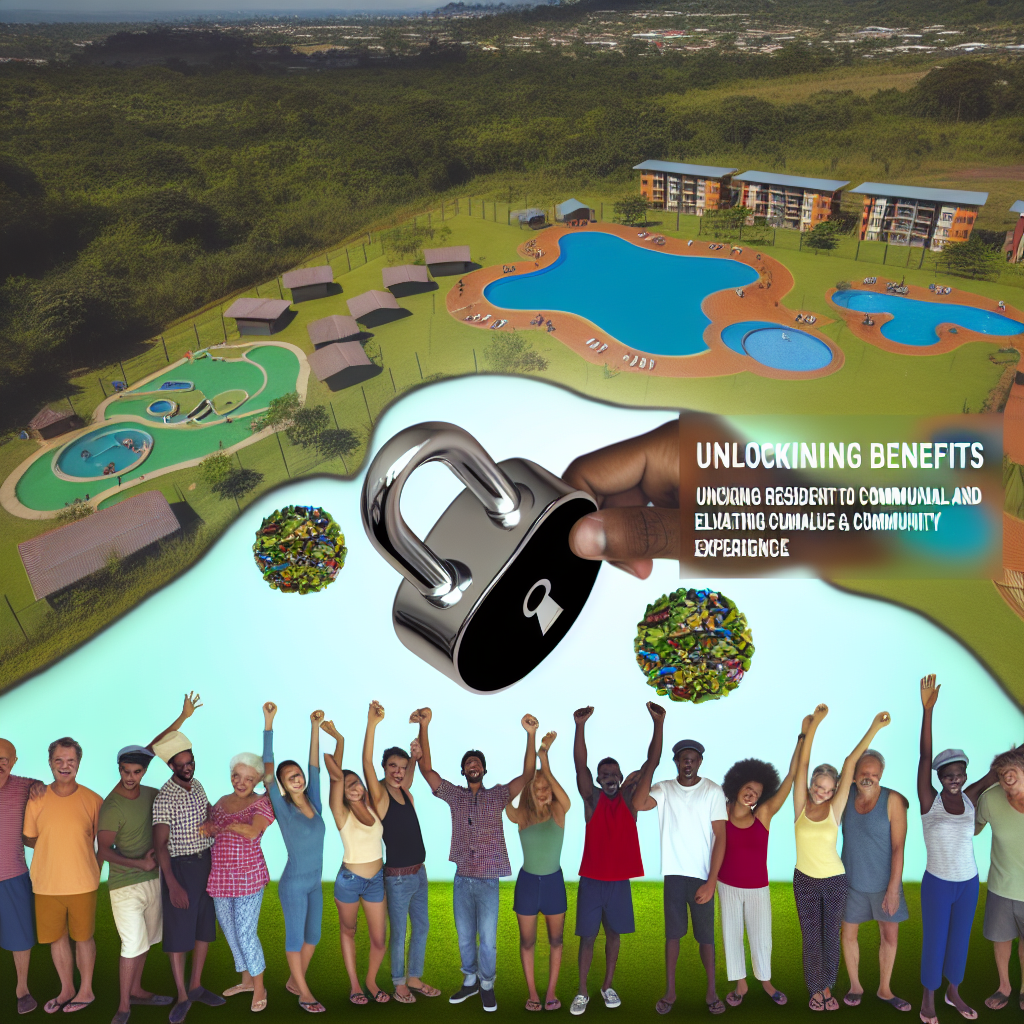Maximizing Resident Benefits: Innovative Community Amenities for Enhanced Tenant Experience in 2025
As we approach 2025, the landscape of residential living is undergoing a significant transformation, driven by the evolving expectations of tenants and the innovative strategies employed by property managers. Maximizing resident benefits through innovative community amenities has become a focal point for enhancing the tenant experience. This shift is not merely about providing basic facilities but rather about creating a holistic living environment that fosters community engagement, well-being, and convenience. As such, property developers and managers are increasingly investing in amenities that cater to the diverse needs of modern residents, ensuring that their living spaces are not just places to reside but vibrant communities to thrive in.
One of the key strategies in enhancing tenant experience is the integration of technology-driven amenities. Smart home technologies, for instance, have become a staple in modern residential communities. These technologies offer residents enhanced control over their living environments, from smart thermostats and lighting systems to advanced security features. By providing these conveniences, property managers not only improve the quality of life for residents but also demonstrate a commitment to sustainability and energy efficiency, which are increasingly important to today’s environmentally conscious tenants.
In addition to technological advancements, the focus on wellness and health-oriented amenities is gaining momentum. Fitness centers, yoga studios, and wellness spas are becoming standard features in residential communities. However, the trend is moving beyond traditional offerings to include innovative solutions such as virtual fitness classes, meditation gardens, and even on-site nutritionists. These amenities cater to the growing demand for health and wellness options, allowing residents to maintain a balanced lifestyle without leaving the comfort of their community.
Furthermore, the importance of fostering a sense of community cannot be overstated. Social spaces such as communal lounges, rooftop gardens, and co-working areas are being designed to encourage interaction among residents. These spaces serve as platforms for socialization, collaboration, and networking, thereby enhancing the sense of belonging and community spirit. Events and activities organized by property management, such as community dinners, workshops, and cultural festivals, further strengthen these bonds, creating a vibrant and inclusive community atmosphere.
Moreover, the concept of convenience is being redefined with the introduction of on-demand services and amenities. From concierge services and package delivery lockers to car-sharing programs and pet care facilities, these offerings are designed to simplify the lives of residents. By providing such conveniences, property managers are not only meeting the practical needs of tenants but also adding significant value to their living experience.
As we look towards 2025, it is clear that the future of residential living lies in the ability to adapt and innovate. Property managers who embrace these changes and invest in enhancing resident benefits through innovative community amenities will undoubtedly set themselves apart in a competitive market. By prioritizing technology, wellness, community engagement, and convenience, they can create living environments that not only meet but exceed the expectations of modern tenants. In doing so, they will not only enhance tenant satisfaction and retention but also contribute to the overall success and sustainability of their residential communities. As the industry continues to evolve, these strategies will serve as a blueprint for maximizing resident benefits and elevating the tenant experience to new heights.
Elevating Community Value: Expert Strategies for Convenient Living and Property Perks in 2025
As we approach 2025, the landscape of community living is undergoing a significant transformation, driven by innovative strategies aimed at enhancing resident benefits and elevating property value. The focus is increasingly on creating environments that not only meet the basic needs of residents but also offer a range of conveniences and perks that enrich their daily lives. This shift is largely influenced by the growing demand for integrated living solutions that seamlessly blend comfort, accessibility, and sustainability.
One of the primary strategies being employed to elevate community value is the integration of smart technology within residential spaces. Smart home devices, such as automated lighting, climate control systems, and security features, are becoming standard offerings in many communities. These technologies not only provide convenience but also contribute to energy efficiency, aligning with the broader goal of sustainable living. By reducing energy consumption and enhancing security, smart technologies offer tangible benefits that increase the appeal of properties to potential residents.
In addition to technological advancements, there is a strong emphasis on fostering a sense of community among residents. This is being achieved through the development of shared spaces and amenities that encourage social interaction and engagement. Community gardens, co-working spaces, and recreational facilities are just a few examples of how residential areas are being designed to promote a sense of belonging and collaboration. These shared spaces not only enhance the quality of life for residents but also contribute to the overall value of the property by creating a vibrant and cohesive community atmosphere.
Moreover, the concept of convenience is being redefined through the introduction of on-demand services and amenities. From concierge services to fitness classes and wellness programs, communities are offering a range of perks that cater to the diverse needs and preferences of residents. These services are designed to simplify daily life, allowing residents to focus on what truly matters to them. By providing such conveniences, property managers are able to differentiate their offerings in a competitive market, thereby attracting and retaining residents.
Sustainability remains a key consideration in the development of modern communities. As environmental concerns continue to rise, there is a concerted effort to incorporate green building practices and eco-friendly amenities. This includes the use of sustainable materials, the implementation of waste reduction programs, and the creation of green spaces that enhance biodiversity. By prioritizing sustainability, communities not only contribute to environmental preservation but also appeal to environmentally conscious residents who value responsible living.
Furthermore, the importance of accessibility cannot be overstated. Ensuring that communities are inclusive and accessible to all residents, regardless of age or ability, is a critical component of modern community planning. This involves designing spaces that are easy to navigate and providing amenities that cater to a wide range of needs. By prioritizing accessibility, communities can create environments that are welcoming and accommodating, thereby enhancing the overall living experience for all residents.
In conclusion, the strategies being implemented to elevate community value in 2025 are multifaceted, focusing on technology, social engagement, convenience, sustainability, and accessibility. By adopting these expert strategies, communities are not only enhancing the living experience for residents but also increasing the desirability and value of their properties. As we move forward, it is clear that the future of community living lies in creating environments that are not only functional but also enriching and sustainable.
Revolutionizing On-Site Trash Management: A Key to Improving Resident Benefits and Community Living in 2025
In the evolving landscape of residential communities, the year 2025 promises to bring innovative strategies that enhance resident benefits and improve community living. One pivotal area of focus is the revolutionization of on-site trash management. As urban areas continue to expand and the demand for sustainable living solutions grows, effective waste management becomes a cornerstone of community well-being. By implementing advanced waste management systems, residential communities can significantly enhance the quality of life for their residents while promoting environmental sustainability.
To begin with, the integration of smart waste management technologies is set to transform how communities handle trash. These technologies include sensor-equipped bins that monitor waste levels in real-time, allowing for more efficient collection schedules. By reducing the frequency of unnecessary waste collection trips, communities can lower their carbon footprint and operational costs. Moreover, these smart systems can alert maintenance teams to overflowing bins, thereby preventing unsightly and unhygienic conditions that can detract from the community’s appeal.
In addition to technological advancements, community education plays a crucial role in revolutionizing on-site trash management. Educating residents about proper waste segregation and recycling practices can lead to a more efficient waste management process. Workshops and informational campaigns can empower residents to take an active role in reducing waste, thus fostering a sense of community responsibility and pride. Furthermore, by promoting a culture of sustainability, communities can attract environmentally conscious residents who value green living initiatives.
Another strategy involves the implementation of centralized waste collection points within residential complexes. These designated areas can be equipped with recycling stations and composting facilities, encouraging residents to sort their waste appropriately. Centralized collection points not only streamline waste management but also reduce the need for multiple collection routes, thereby minimizing traffic congestion and noise pollution within the community. This approach not only enhances the aesthetic appeal of the community but also contributes to a more harmonious living environment.
Moreover, partnerships with local waste management companies can further enhance on-site trash management. By collaborating with experts in the field, residential communities can benefit from tailored waste management solutions that address their specific needs. These partnerships can also facilitate access to advanced recycling technologies and waste-to-energy initiatives, which can convert waste into valuable resources. Such collaborations can lead to cost savings for the community, which can be redirected towards other resident benefits and amenities.
In conclusion, revolutionizing on-site trash management is a key strategy for improving resident benefits and community living in 2025. By embracing smart technologies, fostering community education, implementing centralized collection points, and partnering with waste management experts, residential communities can create a cleaner, more sustainable living environment. These efforts not only enhance the quality of life for residents but also contribute to broader environmental goals. As communities continue to evolve, the focus on innovative waste management solutions will undoubtedly play a critical role in shaping the future of residential living. Through these expert strategies, communities can ensure that they remain attractive, sustainable, and vibrant places to live, ultimately benefiting both current and future residents.
Unlock the future of community living with our expert strategies for 2025! Discover how to enhance resident benefits and elevate your community experience. [Learn more now](https://americantrashservice.com).



